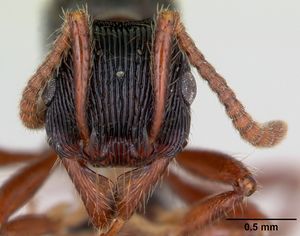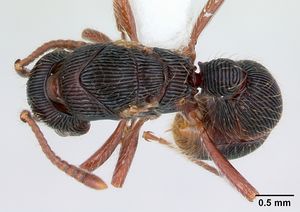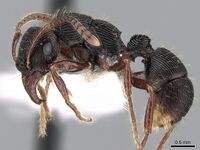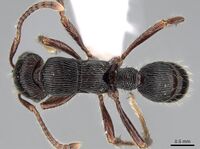Poneracantha rastrata
| Poneracantha rastrata | |
|---|---|

| |
| Scientific classification | |
| Kingdom: | Animalia |
| Phylum: | Arthropoda |
| Class: | Insecta |
| Order: | Hymenoptera |
| Family: | Formicidae |
| Subfamily: | Ectatomminae |
| Tribe: | Ectatommini |
| Genus: | Poneracantha |
| Species: | P. rastrata |
| Binomial name | |
| Poneracantha rastrata (Mayr, 1866) | |
| Synonyms | |
| |
Captured in wet forests, including montane areas. A millipede feeder.
Identification
A member of the rastrata complex (in the rastrata subgroup of the rastrata species group). Antennal scapes surpass vertexal margin by no more than their apical width; triangular and edentate mandibles with a varying degree of costulate and rugae; small tubercle-like propodeal teeth next to conspicuous spiracles which are slightly elevated above rest of surrounding cuticle; postpetiolar sternum with median longitudinal smooth and shining areas. The sculpture on the node as seen dorsally can vary from concentric costulae, with transverse or longitudinal costulae in the middle, or completely transverse. The petiolar node can be wider than long or the opposite. Size range is HL 0.74-0.90; WL 1.10-1.28 mm. (Lattke 1995)
Keys including this Species
Distribution
Latitudinal Distribution Pattern
Latitudinal Range: -14.75° to -30.700556°.
| North Temperate |
North Subtropical |
Tropical | South Subtropical |
South Temperate |
- Source: AntMaps
Distribution based on Regional Taxon Lists
Neotropical Region: Argentina, Brazil (type locality), Paraguay.
Distribution based on AntMaps
Distribution based on AntWeb specimens
Check data from AntWeb
Countries Occupied
| Number of countries occupied by this species based on AntWiki Regional Taxon Lists. In general, fewer countries occupied indicates a narrower range, while more countries indicates a more widespread species. |

|
Estimated Abundance
| Relative abundance based on number of AntMaps records per species (this species within the purple bar). Fewer records (to the left) indicates a less abundant/encountered species while more records (to the right) indicates more abundant/encountered species. |

|
Biology
Castes
Queen
Images from AntWeb
   
| |
| Queen (alate/dealate). Specimen code casent0173385. Photographer April Nobile, uploaded by California Academy of Sciences. | Owned by ALWC, Alex L. Wild Collection. |
Nomenclature
The following information is derived from Barry Bolton's Online Catalogue of the Ants of the World.
- rastrata. Ectatomma rastratum Mayr, 1866b: 890 (q.) BRAZIL (no state data).
- Type-material: holotype queen.
- Type-locality: Brazil: (no further data) (F. Sahlberg).
- Type-depository: NHMW.
- [Misspelled as rostratum by Emery, 1890b: 41, and others.]
- Brown, 1958g: 322 (w.).
- Combination in Ectatomma (Rhytidoponera): Mayr, 1887: 539;
- combination in E. (Gnamptogenys): Emery, 1890b: 41;
- combination in E. (Parectatomma): Emery, 1911d: 44;
- combination in Gnamptogenys: Brown, 1958g: 229;
- combination in Poneracantha: Camacho, Franco, Branstetter, et al. 2022: 11.
- Status as species: Emery, 1890b: 41; Dalla Torre, 1893: 25; Emery, 1894k: 47; Forel, 1895b: 113; Emery, 1896g: 46 (in key); Forel, 1899c: 9; Emery, 1911d: 44; Borgmeier, 1923: 59; Wheeler, W.M. 1925a: 5; Brown, 1958g: 229, 321 (redescription); Kempf, 1972a: 114; Kempf & Lenko, 1976: 52; Bolton, 1995b: 210; Lattke, 1995: 180; Wild, 2007b: 27; Lattke, et al. 2007: 263 (in key); Bezděčková, et al. 2015: 111; Feitosa, 2015c: 98; Camacho, et al. 2020: 461 (in key); Camacho, Franco, Branstetter, et al. 2022: 11.
- Senior synonym of trigona: Lattke, 1995: 180; Camacho, Franco, Branstetter, et al. 2022: 11.
- Distribution: Argentina, Bolivia, Brazil, Paraguay, Peru.
- trigona. Ectatomma (Gnamptogenys) trigonum Emery, 1906c: 114 (footnote) (q.) BRAZIL (Santa Catarina).
- Type-material: holotype queen.
- Type-locality: Brazil: Santa Catarina, Nova Friburgo (no collector’s name, possibly F. Silvestri).
- Type-depository: MSNG.
- Brown, 1958g: 323 (w.).
- Combination in E. (Parectatomma): Emery, 1911d: 44;
- combination in Gnamptogenys: Brown, 1958g: 230.
- Status as species: Emery, 1911d: 44; Borgmeier, 1923: 60; Brown, 1958g: 230, 322; Kempf, 1972a: 116; Bolton, 1995b: 211.
- Junior synonym of rastrata: Lattke, 1995: 180; Camacho, Franco, Branstetter, et al. 2022: 11.
Description
References
- Brown, W. L., Jr. 1958g. Contributions toward a reclassification of the Formicidae. II. Tribe Ectatommini (Hymenoptera). Bulletin of the Museum of Comparative Zoology 118: 173-362 (page 229, Combination in Gnamptogenys)
- Camacho, G.P., Franco, W., Branstetter, M.G., Pie, M.R., Longino, J.T., Schultz, T.R., Feitosa, R.M. 2022. UCE phylogenomics resolves major relationships among Ectaheteromorph ants (Hymenoptera: Formicidae: Ectatomminae, Heteroponerinae): A new classification for the subfamilies and the description of a new genus. Insect Systematics and Diversity 6(1): 5; 1–20 (doi:10.1093/isd/ixab026).
- Camargo, K.S. de. 2011. Composicao e diversidade de "Poneromorfas" (Hymenoptera, Formicidae) em duas fitofisionomias de cerrado e padroes de distribuicao de "Poneromorfas", Pseudomyrmecinae e Cephalotini (Myrmicinae) para o Brasil. Thesis, Universidade de Brasilia.
- Cantone S. 2018. Winged Ants, The queen. Dichotomous key to genera of winged female ants in the World. The Wings of Ants: morphological and systematic relationships (self-published).
- Emery, C. 1890c. Studii sulle formiche della fauna neotropica. Bull. Soc. Entomol. Ital. 22: 38-80 (page 41, Combination in E. (Gnamptogenys))
- Emery, C. 1911e. Hymenoptera. Fam. Formicidae. Subfam. Ponerinae. Genera Insectorum 118: 1-125 (page 44, Combination in E. (Parectatomma))
- Lattke, J. E. 1995. Revision of the ant genus Gnamptogenys in the New World (Hymenoptera: Formicidae). Journal of Hymenoptera Research. 4:137-193.
- Lattke, J.E., Fernández, F. & Palacio, E.E. 2007. Identification of the species of Gnamptogenys Roger in the Americas (pp. 254-270). In Snelling, R.R., Fisher, B.L. & Ward, P.S. (eds). Advances in ant systematics: homage to E.O. Wilson – 50 years of contributions. Memoirs of the American Entomological Institute 80: 690 pp.
- Mayr, G. 1866b. Diagnosen neuer und wenig gekannter Formiciden. Verh. K-K. Zool.-Bot. Ges. Wien 16: 885-908 (page 890, queen described)
References based on Global Ant Biodiversity Informatics
- Bihn J. H., M. Verghaagh, M. Brandle, and R. Brandl. 2008. Do secondary forests act as refuges for old growth forest animals? Recovery of ant diversity in the Atlantic forest of Brazil. Biological Conservation 141: 733-743.
- Borgmeier T. 1923. Catalogo systematico e synonymico das formigas do Brasil. 1 parte. Subfam. Dorylinae, Cerapachyinae, Ponerinae, Dolichoderinae. Archivos do Museu Nacional (Rio de Janeiro) 24: 33-103.
- Brown W. L., Jr. 1958. Contributions toward a reclassification of the Formicidae. II. Tribe Ectatommini (Hymenoptera). Bulletin of the Museum of Comparative Zoology 118: 173-362.
- Emery C. 1890. Studii sulle formiche della fauna neotropica. Bull. Soc. Entomol. Ital. 22: 38-8
- Emery C. 1894. Estudios sobre las hormigas de Costa Rica. Anales del Museo Nacional de Costa Rica 1888-1889: 45-64.
- Emery C. 1911. Hymenoptera. Fam. Formicidae. Subfam. Ponerinae. Genera Insectorum 118: 1-125.
- Favretto M. A., E. Bortolon dos Santos, and C. J. Geuster. 2013. Entomofauna from West of Santa Catarina State, South of Brazil. EntomoBrasilis 6 (1): 42-63.
- Kempf W. W. 1978. A preliminary zoogeographical analysis of a regional ant fauna in Latin America. 114. Studia Entomologica 20: 43-62.
- Kempf W. W., and K. Lenko. 1976. Levantamento da formicifauna no litoral norte e ilhas adjacentes do Estado de São Paulo, Brasil. I. Subfamilias Dorylinae, Ponerinae e Pseudomyrmecinae (Hym., Formicidae). Studia Entomologica 19: 45-66.
- Kempf, W.W. 1972. Catalago abreviado das formigas da regiao Neotropical (Hym. Formicidae) Studia Entomologica 15(1-4).
- Lattke J. E. 1995. Revision of the ant genus Gnamptogenys in the New World (Hymenoptera: Formicidae). Journal of Hymenoptera Research 4: 137-193
- Pires de Prado L., R. M. Feitosa, S. Pinzon Triana, J. A. Munoz Gutierrez, G. X. Rousseau, R. Alves Silva, G. M. Siqueira, C. L. Caldas dos Santos, F. Veras Silva, T. Sanches Ranzani da Silva, A. Casadei-Ferreira, R. Rosa da Silva, and J. Andrade-Silva. 2019. An overview of the ant fauna (Hymenoptera: Formicidae) of the state of Maranhao, Brazil. Pap. Avulsos Zool. 59: e20195938.
- Rosa da Silva R. 1999. Formigas (Hymenoptera: Formicidae) do oeste de Santa Catarina: historico das coletas e lista atualizada das especies do Estado de Santa Catarina. Biotemas 12(2): 75-100.
- Rosa da Silva R., and B. Cortes Lopes. 1997. Ants (Hymenoptera: Formicidae) from Atlantic rainforest at Santa Catarina Island, Brazil: two years of sampling. Rev. Biol. Trop. 45(4): 1641-1648.
- Rosumek, F.B., M.A. Ulyssea, B.C. Lopes, J. Steiner. 2008. Formigas de solo e de bromélias em uma área de Mata Atlântica, Ilha de Santa Catarina, sul do Brasil: Levantamento de espécies e novos registros. Revista Biotemas 21(4):81-89.
- Silva R. R., R. S. Machado Feitosa, and F. Eberhardt. 2007. Reduced ant diversity along a habitat regeneration gradient in the southern Brazilian Atlantic Forest. Forest Ecology and Management 240: 61-69.
- Silva R.R., and C. R. F. Brandao. 2014. Ecosystem-Wide Morphological Structure of Leaf-Litter Ant Communities along a Tropical Latitudinal Gradient. PLoSONE 9(3): e93049. doi:10.1371/journal.pone.0093049
- Ulyssea M.A., C. E. Cereto, F. B. Rosumek, R. R. Silva, and B. C. Lopes. 2011. Updated list of ant species (Hymenoptera, Formicidae) recorded in Santa Catarina State, southern Brazil, with a discussion of research advances and priorities. Revista Brasileira de Entomologia 55(4): 603-611.
- Wheeler W. M. 1925. Neotropical ants in the collections of the Royal Museum of Stockholm. Arkiv för Zoologi 17A(8): 1-55.
- Wild, A. L.. "A catalogue of the ants of Paraguay (Hymenoptera: Formicidae)." Zootaxa 1622 (2007): 1-55.

